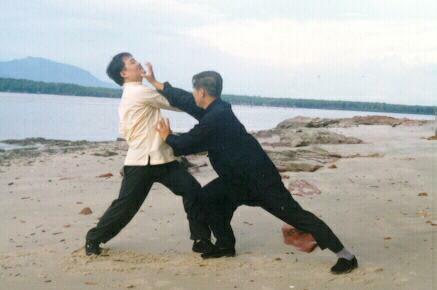KUNGFU, SPARRING AND CHI KUNG

Sparring is an essential part of kungfu
Question
Or perhaps this is all part of my Sifu's plan and I am just not at a high enough level to begin to learn to spar or learn chi kung. I am, after all, only learning my fourth form (or set). Please advise me Sifu Wong, I am uncertain of the right path.
-- Edward, USA
Answer
If you are already learning your fourth form and yet cannot use your kungfu patterns to spar, it is evident that your teacher pays much attention to form practice and little attention to combat efficiency. But this is the norm today. Often it does not mattter whether a student has learnt for 6 months or 20 years. After 20 years, the student (although he might have used the term “master” for himself long before this time) might have learnt, say, 50 forms or sets, yet he could not effectively use his kungfu patterns to spar.
The norm in the past was different. Kungfu students in the past knew how to spar using kungfu pattterns after they had learnt their first form or set. From the stories told to me by my own masters as well as from reading classical kungfu literature, I know that kungfu students (both monks and secular disciples) at the southern Shaolin Monastery in China could use their kungfu patterns to spar before they learned their first form.
The great Yang Style Taijiquan first patriarch, Yang Lu Chan, had only one kungfu set, and it was just called Taijiquan. It was much later that other sets were invented for Tai Chi dancing. The great lady kungfu master, Yim Wing Choon, practised only one set, which she developed from another set called Flower Set that she had earlier learnt from her teacher the Shaolin nun Ng Mooi. Yim Wing Choon did not even have a name for her special kungfu set; later people named the set Wing Choon Kungfu after her.
My master, Sifu Ho Fatt Nam, told me that he had to spend more than three years on force training, especially on “One Finger Shooting Zen”, and some fundamental kungfu patterns, before his teacher taught him an apparently simple kungfu set called “Sap Tze Sei Moon Khuen” in Cantonese. This “Sap Tze Sei Moon Khuen”, which means “Crossroads at Four Gates”, was the kungfu set taught at the southern Shaolin Monastery in the past.
Informal chi kung is taught together with the forms right at the beginning. Chi kung, which is energy management, is an integral part of real kungfu. Formal chi kung, which generally take the form of specialized force training, is usually taught much later.
Being able to use kungfu patterns for self defence is a fundamental kungfu objective taught at the very beginning. At the intermediate level, the emphasis is on force training. If you read classical kungfu literature, you will inevitably find that the main preoccupation of most kungfu students and masters was how to enhance their “gong” (pronounced as “kung”, and which may be conveniently translated as kungfu force). At the highest level, where only a few could attain, the emphasis is on mind expansion and spiritual cultivation.
Even amongst kungfu styles whose aim was solely combat efficiency, using kungfu patterns for combat was taught at the beginning. Then the students progressed to train force as well as to learn tactics and strategies for more efficient combat. Hence, if a kungfu teacher keeps his teaching of combat application for his advanced programme, it is likely that he does not have much scope and depth to teach.
The above is taken from Question 18 of March 1999 Part 2 of the Selection of Questions and Answers.
LINKS
Courses and Classes
